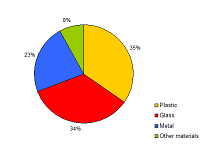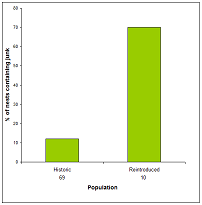
The Critically Endangered California Condor was brought back from the brink of extinction through intensive management. Lead poising from ingestion of ammunition fragments in carcasses, however, is preventing the wild population from becoming self-sustaining.

California Condor Gymnogyps californianus became extinct in the wild in 1987 following precipitous population declines as a result of habitat destruction, persecution and lead poisoning (Cade 2007). A small free-flying population of over 100 individuals now exist in the wild, however, thanks to the California Condor Recovery Program (Myra et al. 2014). Unfortunately the re-establishment of a wild breeding population of Critically Endangered California Condor is still threatened by poisoning from lead-based ammunition (Walters et al. 2010).
Re-introduced adults become increasingly exposed as they become less reliant on provisioned food (Kelly et al. 2014) and ingest fragments of lead bullets from the remains of animals shot by hunters (Houston et al. 2007; Parish et al. 2009). Due to their longevity and delayed-onset breeding strategy lead can build up in the blood to dangerous levels over the years (Hunt et al. 2007). One study found that around one third of condors in California are experiencing toxicological effects from lead ammunition (Finkelstein et al. 2012) and since 1997 about half of all free-flying condors in California have required treatment for lead poisoning (Myra et al. 2014). If the species were not treated, mortality rates would rise above for required for sustainability (Walters et al. 2010).

Lead poisoning also affects nestling mortality, of the 13 breeding attempts in the wild since 2001, only one has resulted in successful fledging. Since 2002 eight nestlings have died in the nest or were removed from the wild, and six of these had swallowed substantial quantities of glass shards, metal bottle-tops, ammunition cartridges, electrical wiring, plastic piping, pieces of rubber and cloth (see figure a). The ingestion of this junk was the direct cause of mortality in two cases and contributed strongly to others. Two nestlings were found to have ingested their own body weight in junk and one nestling suffered from zinc poisoning as a result of metal ingestion. Most nestlings also showed retarded feather development as a result of malnutrition stemming from distended and blocked digestive systems (Mee et al. 2007).
Although efforts have been made to clean up sites frequented by condors and limit the use of lead-based ammunition this species will require intensive management if it is to persist in the wild (Mee et al. 2007; Myra et al. 2014).
Related Case Studies in other sections
Related Species
References
Cade, T. J. (2007) Exposure of California Condors to lead from spent ammunition. J. Wildl. Manage. 71: 2125–2133.
Finkelstein, M. E., Doak, D. F., George, D., Burnett, J., Brandt, J., Church, M., Grantham, J., and Smith, D.R. (2012) Lead poisoning and the deceptive recovery of the critically endangered California condor. PNAS. doi: 10.1073/pnas.1203141109.
Houston, D. C., Mee, A., and McGrady, M. (2007) Why do condors and vultures eat junk? The implications for conservation. J. Rapt. Res. 41: 235–238.
Hunt, W. G., Parish, C.N., Farry, S.C., Lord, T. G., and Sieg, R. (2007) Movements of introduced California Condors in Arizona in relation to lead exposure. In: Mee, A; Hall, LS; Grantham, J (ed.), California Condors in the 21st century, pp. 79-96. American Ornithologists Union, McLean, VA, U.S.A.
Kelly, T. R., Grantham, J., George, D., Welch, A., Brandt, J., Burnett, L. J., Sorenson, K. J., Johnson, M., Battistone, C., and Johnson, C.K. (2014) Spatiotemporal patterns and risk factors for lead exposure in endangered California Condors during 15 years of reintroduction. Conservation Biology 28(6): 1721-1730.
Mee, A., Rideout, B. A., Hamber, J. A., Todd, N., Austin, G., Clark, M. and Wallace, M. P. (2007) Junk ingestion and nestling mortality in a reintroduced population of California Condors Gymnogyps californianus. Bird Conserv. Int. 17: 119–130.
Parish, C. N., Heinrich, W. R., and Hunt, W. G. (2007) Lead exposure, diagnosis, and treatment in California Condors released in Arizona. In: Mee, A; Hall, LS; Grantham, J (ed.), California Condors in the 21st century, pp. 97-108. American Ornithologists Union, McLean, VA, U.S.A.
Myra, E. F., Doak, D. F., George, G., Burnet, J., Brandt, J., Church, M., Grantham, J. and Smith, D. R. (2014) Lead poisoning and the deceptive recovery of the critically endangered California condor. PNAS. 109: 11449-11454. doi:10.1073.pnas.1203141109
Walters, J. R., Derrickson, S. R., Fry, D. M., Haig, S. M., Marzluff, J. M., and Wunderle, J. M., Jr. (2010) Status of the California Condor (Gymnogyps californianus) and efforts to achieve its recovery. Auk 127(4): 969-1001.
Compiled: 2008 Last updated: 2017
Recommended Citation:
BirdLife International (2017)
Anthropogenic junk ingestion leads to high nestling mortality in vultures and condors.
Downloaded from https://datazone.birdlife.org/sowb/casestudy/lead-poisoning-is-preventing-the-recovery-of-california-condor on 22/12/2024